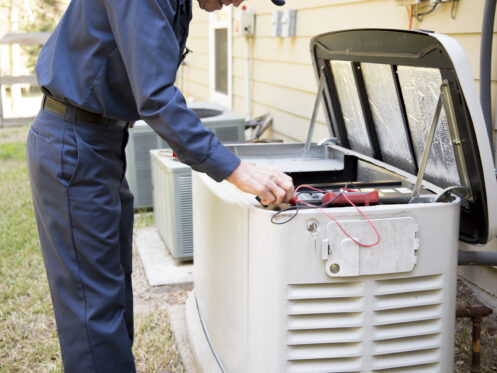With each passing year, our collective demand for electricity in our homes continues to climb. And as it does, the strain on our aging electrical grid and power generation infrastructure grows. As a result, things like blackouts and brownouts are becoming common events. For homeowners, those events are inconvenient at best and potentially life-threatening at worst. For example, when the power goes out in the middle of a heatwave, it can pose a danger to everyone in your home. That’s a big reason why so many homeowners are exploring solutions like backup generators to keep critical appliances and devices running when the grid fails. However, you can’t simply hook up a generator to your home’s wiring and turn it on. For that, you need a way to disconnect your home from the grid before your generator comes online. That’s what a manual transfer switch does. Here’s a complete explanation of manual transfer switches and the types you can choose from if you’d like a backup generator for your home.
What Is a Manual Transfer Switch?
A manual transfer switch is a device installed between your home’s wiring and the electrical grid. It allows you to disconnect your home from the grid and connect it instead to the power flowing from a generator. It’s a requirement if you want to use a generator of any kind to power outlets inside your home. The reason a manual transfer switch is necessary is simple. It’s that electricity flows in any direction that a connected conductor will carry it. So, when there’s a brownout or blackout, plugging in and turning on a generator would send electricity back into the grid.
That could pose an electrocution risk to any power company employees working on lines nearby. Plus, your home’s circuitry would overload if the grid power came back on while you had your generator running, potentially causing a fire.
Types of Manual Transfer Switches
There are a few specific types of manual transfer switches that you may choose depending on how you plan to use your backup generator. They all vary slightly in the way they work, but all accomplish the same basic task. Here are the three most popular options.
A Back Feed Breaker and Interlock Switch
The first type of manual transfer switch consists of a back feed breaker and an interlock switch. In this configuration, you’d have an additional circuit breaker installed in your home’s main electrical panel with wiring that runs to your generator. That circuit breaker would serve as a way to allow power from your generator to enter your home’s wiring. More importantly, however, the breaker would have a metal overlay that could slide back and forth with its switch. The overlay would force your home’s main circuit breaker to turn off any time the back feed breaker was in the “on” position. It’s a simple mechanical way to guarantee that you could never have power from the grid and your generator running into your home simultaneously.
The main downside to using a back feed breaker and interlock switch as your manual transfer switch is that your main electrical panel must have enough free space to accommodate it. If yours doesn’t, you’d either need to upgrade your home’s main panel or choose another manual transfer switch option. Plus, this setup would also send power from your generator to every circuit in your home. So, if your generator isn’t powerful enough to handle your whole home’s demand, you’d need to turn off individual circuits yourself to prioritize the ones you’d like to power with your generator.
A Single-Load Manual Transfer Switch Panel
Another option you could choose is a single-load manual transfer switch panel. With this option, you would relocate your home’s incoming electrical service to a brand-new electrical box. The box would include nothing but the main circuit breaker for your incoming grid service and another one for your generator source. Just as with the previous option, the two breakers would remain linked such that only one could be in the on position at any given time. The output of the panel would then feed into your main electrical service panel.
A single-load manual transfer switch panel has the same weaknesses as a back feed breaker and interlock switch. With this option, you’d still have to shut off breakers in your main panel to prevent overloading your generator. The biggest advantage, however, is price. A single-load manual transfer switch panel isn’t very expensive to install. Therefore, it is often the most cost-effective option if you don’t have room in your existing electrical service panel to accommodate a back feed breaker and interlock switch.
A Manual Transfer Switch Distribution Panel
The final main type of manual transfer switch you could choose is a manual transfer switch distribution panel. This, too, is a standalone electrical box that would house your main grid power circuit breaker and another for your generator power. The difference is that it also contains circuits that represent the parts of your home that you’d like to keep powered in the event of a grid failure.
Before installing a manual transfer switch distribution panel, you’d need to work with one of our electricians to figure out how many circuits in your home your generator could support on its own. Then, they’d work with you to decide which circuits you want to prioritize during a grid failure. For example, you’d likely want to keep the circuits with your refrigerator and necessary cooking appliances connected. Plus, you’d likely want your home’s HVAC system connected to your generator if it provides enough power to support it. Then, you’d want enough lights and outlets working in your home to make it habitable during a power outage.
With your circuits chosen, our electrician will then install your new transfer switch distribution panel. They’d link the new panel’s breakers to each circuit in your main electrical panel according to your wishes. Then, when you activate your transfer switch, you’ll automatically disconnect your home from the grid and send power from your generator only to the circuits you’ve chosen to prioritize.
Your Generator and Manual Transfer Switch Specialists
Huft Home Services is the place to go in Sacramento, CA, and the surrounding area if you need a manual transfer switch installed to support a home backup generator. We even sell and install standby generators and can help you choose the perfect one for your needs. That’s just one of our electrical services, which also includes panel upgrades, EV chargers, surge protectors, wiring, outlets, and any other electrical needs your home might have. Plus, we also offer comprehensive HVAC services, including installation, maintenance, and repair, as well as complete residential plumbing services. Since 2004, we’ve been the area’s go-to home services company, and we’d be delighted to show you why with our 5-star customer experience.
For manual transfer switch installations, generator services, and more, call the experts at Huft Home Services today!




